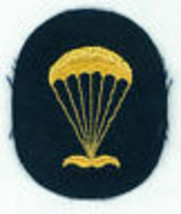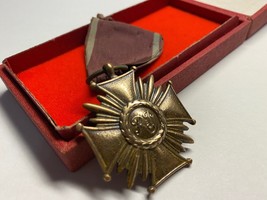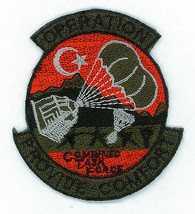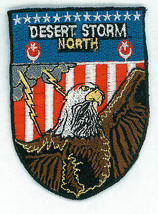1st Special Forces Battalion, 10th Special and 37 similar items
1st SPECIAL FORCES BATTALION, 10th SPECIAL FORCES GROUP, BAD TOLZ, GERMANY, CERT
$20.79 CAD
View full item details »
Shipping options
Seller handling time is 1 business day Details
No shipping price specified to CA
Ships from
United States

Return policy
Full refund available within 30 days
Details
Purchase protection
Payment options
PayPal accepted
PayPal Credit accepted
Venmo accepted
PayPal, MasterCard, Visa, Discover, and American Express accepted
Maestro accepted
Amazon Pay accepted
Nuvei accepted
View full item details »
Shipping options
Seller handling time is 1 business day Details
No shipping price specified to CA
Ships from
United States

Return policy
Full refund available within 30 days
Details
Purchase protection
Payment options
PayPal accepted
PayPal Credit accepted
Venmo accepted
PayPal, MasterCard, Visa, Discover, and American Express accepted
Maestro accepted
Amazon Pay accepted
Nuvei accepted
Item traits
| Category: | |
|---|---|
| Quantity Available: |
Only one in stock, order soon |
| Condition: |
New |
| Country/Region of Manufacture: |
Germany |
| Country of Manufacture: |
Germany |
| Theme: |
Militaria |
| Type: |
CERTIFICATE |
Listing details
| Seller policies: | |
|---|---|
| Shipping discount: |
No combined shipping offered |
| Posted for sale: |
May 1 |
| Item number: |
1743629883 |
Item description
1st SPECIAL FORCES BATTALION, 10th SPECIAL FORCES GROUP, BAD TOLZ, GERMANY, CERTIFICATE, OBSOLETE, VINTAGE
Original unsigned certificate. Mint condition. Printed in Germany.
Measures approx. 8.25 x 11.75 inches.
Images of Flint Kaserne are not included.
Flint Kaserne in Bad Tolz, Germany, long the home of the 1st Battalion, 10th Special Forces Group, closed July 15, 1991, in a ceremony attended by hundreds of local residents, soldiers and former members of its military community. During the ceremony, eight Special forces soldiers parachuted in with the official orders closing the post. Speaking to those in attendance,
Maj. Gen. Eugene L. Daniel, deputy commander of the U.S. Army VII Corps, said the closure was not an occasion for sadness but a reason to rejoice, since it resulted from the end of the Cold War. Also addressing the crowd was retired Col. Aaron Bank, 88, who activated the 10th SF Group, the first Special Forces unit, at Fort Bragg in 1952 and was commander of the 10th when it moved to Bad Tolz in 1953. ?Special Forces men (are) now and always will be a special breed of men ? daring soldiers who will accept calculated risks, risks that go beyond the normal call of duty,? Bank said.
The 10th Group was headquartered at Bad Tolz until 1968, when it moved to Fort Devens, Mass., leaving a battalion-sized element deployed at Bad Tolz. The 1/10th remains in Germany, stationed at Panzer Kaserne in Boblingen, a suburb of Stuttgart
In 1950, the Lodge Act was passed, which provided for the recruiting of foreign nationals into the United States military. It was originally planned that half of the members of the Special Forces would be native Europeans. Many of the initial members of the 10th SFG(A) were Lodge Act recruits, who were strenuously anti-Communist.[11] Among the more notable of these men was Major Larry Thorne, a former Finnish Army soldier who was awarded the Mannerheim Cross during World War II.
The 10th SFG(A) was constituted 19 May 1952 and activated on 11 June 1952, at Fort Bragg, North Carolina, under the command of Colonel Aaron Bank.[8] The group was split in 1953, with one half being sent to Germany, while the other half remained at Fort Bragg to form the core of the 77th Special Forces Group (redesignated as the 7th SFG in 1960).
By the end of June 1952, the group had 122 officers and men assigned.[8] Many had been OSS, Ranger, and Airborne troopers during World War II. The group's mission was to conduct partisan warfare behind Soviet lines in the event of a Soviet invasion of Europe.
On 10 November 1953, the 10th SFG(A) was split in half, with one half deployed to Bad Tolz and Lenggries in West Germany, and the other remaining in Fort Bragg to become the 77th Special Forces Group (which in 1960 became the 7th Special Forces Group).
The green beret was authorized for wear by Col. William E. Ekman, the group commander, in 1954, and it became group policy. By 1955, every soldier in the unit wore a green beret as part of the uniform. However, the Department of the Army (DA) did not recognize the beret as headgear. The DA banned the wear of the beret, but in 1961 it was restored by President Kennedy, a major champion of the Special Forces.
The 10th Group encountered publicity for the first time in 1955 when The New York Times published two articles about the unit, describing them as a "liberation" force designed to fight behind enemy lines. Pictures showed soldiers of the group wearing their berets, with their faces blacked out to conceal their identities.
|
Why are we showing these items?
Booth
BlueGrass Militaria |
|

-
Refine your browsing experience
We can show you more items that are exactly like the original item, or we can show you items that are similar in spirit. By default we show you a mix.
This item has been added to your cart
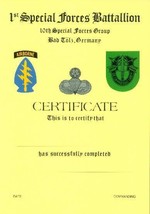 1st SPECIAL FORCES BATTALION, 10th SPECIAL FORCES GROUP, BAD TOLZ, GERMANY, CERT added to cart.
Only one available in stock
1st SPECIAL FORCES BATTALION, 10th SPECIAL FORCES GROUP, BAD TOLZ, GERMANY, CERT added to cart.
Only one available in stock
View Cart or continue shopping.
 Please wait while we finish adding this item to your cart.
Please wait while we finish adding this item to your cart.
Get an item reminder
We'll email you a link to your item now and follow up with a single reminder (if you'd like one). That's it! No spam, no hassle.
Already have an account?
Log in and add this item to your wish list.








